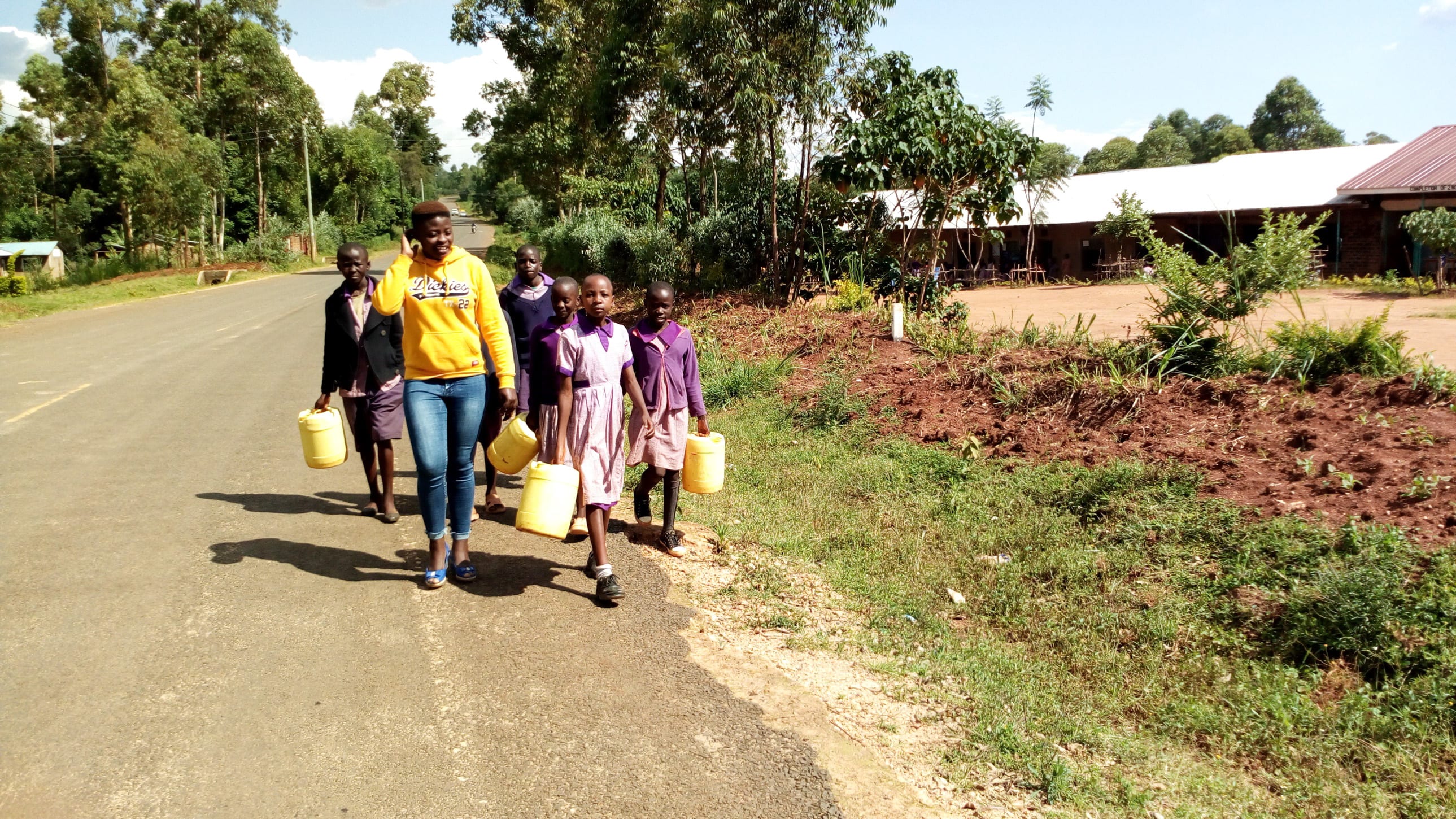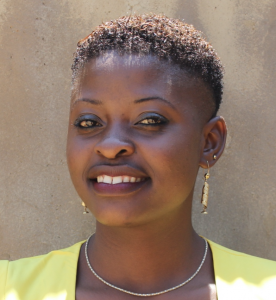October, 2019: Magaka Primary School Project Complete!
Magaka Primary School in Kenya now has access to a new source of safe, clean water thanks to the completion of their rain tank, which has the ability to collect 50,000 liters of water. We installed new latrines for students, handwashing stations, and we trained students and staff on improved sanitation and hygiene practices. All of these components work together to unlock the opportunity for these students to live better, healthier lives.
According to students' parents and school staff, the implementation of this project has been one of the greatest achievements Magaka Primary has ever had as sorrow has been turned into joy. A pupil once broke his leg while he had gone to fetch water at the sping. It was during the rainy season and the boy slid in the mud. With the rain tank completed, this pupil said he was very happy and that he is thanking God for no more going to the spring. He said this will make the pupils safe, thus no one else will break their leg while going in search of water at this school.

Students celebrate their new rain tank
Rain Tank
Construction for this 50,000-liter rain tank was successful!
Parents, staff, and students helped our artisans gather everything needed for construction. All the while, women cooked meals for the artisans, and the school provided accommodations for the artisans during their work. Local women and men helped our artisans with their manual labor, too.
The process officially began with our staff and school administration looking around the school compound to try and determine the best location for a new rain tank. This needed to be the best site with good, clean roofing to catch the rainwater.
Then, we cleared the site: excavating the soil within the required measurements to make level ground for the tank foundation. This process is adventurous in its own way for it commences using various tools like a jembe, spade, and wheelbarrow. The foundation was cast by laying hardcore on level ground and then reinforcing it using steel, concrete and waterproof cement.

Rain tank foundation and outline
Both the drawing pipe as well as the washout pipe were affixed as the foundation was laid. The wall was built with ferro-cement techniques through 6 layers. The inner wall was plastered while rough casting was done on the outer part. Finally, the catchment area was dug, plastered, and a staircase installed.

Cementing the outer rain tank walls
Dome construction could begin after the superstructure had been given enough time to settle. The manhole cover was fitted, inlet pipes were connected to the roof gutters, inlet screens, ventilation pipes (breathers) and overflow pipes were all done to standard.

Soak pit construction after dome was completed
Once finished, the tank was given 3 to 4 weeks to undergo complete curing before it was cleaned and handed over to Magaka Primary School, though we will continue to offer them unmatchable support as a part of our monitoring and maintenance program.
The implementation of the rain tank in this school was the greatest miracle for the parents, teachers, and pupils of Magaka Primary. The completion of works brought so much joy to the whole community and so the parents decided to come to the school to be handed over the project along with the staff and students.

Parents celebrating the new rain tank
The day was very successful for by the time the field officers were arriving at the school, they were all seated and being addressed by Head Teacher Mrs. Jane Ayodi. Then, the pastor of the Pentecostal Assemblies of God, who are the sponsors of the school, made prayers of blessing the organization and thanking God for the project.

Head Teacher Mrs. Jane Ayodi points to the new rain tank
The celebration was a great chance for us to acknowledge the school administration and students as the primary parties entrusted with the tools we’ve given, as well as remind them of our continued support as they develop. The school now has enough water storage and thus will be able to spend more time on academic work, which will help students excel in their studies.
Head Teacher Mrs. Jane Ayodi was beyond pleased with how the rain tank, latrines, and handwashing stations had turned out.
"I am very happy for the school had become a laughing stock and many people could not admit their children in this school. Many could speak loudly while passing by the road saying that the school will not survive and will be closed down because they do not have water and enough toilets," she said.
"This is a different story because many people are surprised seeing the school has a big tank now. As a school, we are very much happy because this is a new dawn for us and indeed change has been brought in [our] school. We really thank God for bringing the donors who have remembered us and have removed the shame."

Cheers to clean water!
VIP Latrines
This project funded the installation of 6 new ventilated improved pit (VIP) latrines, 3 for the girls and 3 for the boys. All of these new latrines have cement floors that are designed to be easy to use and clean. And with a rain tank right on school property, there should be enough water to keep them clean.

Girls in front of their new latrines
With the addition of these new latrines, pupils will no longer share latrines with the teachers as they used to do, and the shame in this has come to an end as the project has now given light to everyone. The school of Magaka Primary is now a place to be with these facilities on the grounds.
Handwashing Stations
The 2 handwashing stations were delivered to the school and handed over to the student health club. These were placed outside of the girls’ and boys’ latrines to encourage handwashing after latrine use.

Girls using a handwashing station
Health club members teach other students how to properly wash their hands at the stations, make sure the stations are filled with water and work to ensure that there is always soap or ash available.
New Knowledge
Hygiene and sanitation training was scheduled with the help of the school principal and teacher Ms. Fanice Ayodi, who together ensured that the training date would be convenient for students, staff, and parent representatives. Individual teachers helped by selecting students from each class to represent the others.
The day of training was cool and cloudy, which was conducive to the training since it was held entirely outside. Some 22 students attended. Though there were some distractions from the sounds of nearby cars and motorbikes passing by on the road, the participants were all attentive and fully participated during the training. They actively asked and answered questions all day.
This was the best group. They understood the nature of their school and so despite the nonconducive learning environment they all made efforts to be attentive and alert.

Facilitator Jemmimah in action getting lots of student participation during training
We covered a number of topics, including personal hygiene such as bathing, oral hygiene, and handwashing with soap as a barrier from germs; and operation and maintenance of the new facilities, with each person understanding their role for long-lasting clean water and good health. The new student health club will be greatly involved in project management and will be responsible for encouraging good health and hygiene practices amongst their peers, teachers, and the larger community.
The participants learned about the benefits of water, sources, storage, factors that contaminate it, prevention of contamination, and treatment. During this session, the participants were very active and asked questions that revolved around the normal aspects of life for every individual. This showed that the training was sinking in and relating to their daily life.

Time to stretch!
The pupils were happy to hear of the benefits of water in our bodies and so they came up with a formula and style of ensuring that they drink the required amount of water. They were singing the numbers "1,1,1,2,2,1" which meant in the morning they drink 1 cup; during the first break at school drink 2 cups; second break 1 cup; lunchtime 2 cups; games time 2 cups; then finally in the evening when they go home the final cup. This was a special topic for this special group and it was a sign of great initiative and innovation.
This was also when all the pupils mastered the 10 handwashing steps and were happily demonstrating them. It was evident through their enthusiasm that the rest of the pupils who did not attend the training will be taught by this group.

Handwashing demonstration
On getting to know the reasons why it is good to clean and disinfect the latrines frequently, the participants then decided that with their student club they will be having a toilet disinfectant day once every month. This was so encouraging for they already had a strategy of how to do it. The chairperson of the group suggested that they will declare an "Ash Competition Week" which will help them bring enough ash into school to disinfect all the toilets, thus ensuring total cleanliness.
"This is the best group I have ever trained because they were so keen, attentive, and ready to learn," said Field Officer and facilitator Jemmimah Khasoha.
"They are ready to come up with initiatives that will keep the group alive and active throughout. Just another initiative they were thinking of was to plant some sukuma wiki (greens) around the tank so when they grow they will sell [them] to the teachers and in return, the money will help them buy soap for handwashing. From my point of view during the training, this group is very good to work with."

12-year-old student Maryanne Machage was very happy and proud at the end of the training for what she had learned.
"This has added to my knowledge and broadened my mind on hygiene practices and skills of management and maintenance," she said.
"This will be my task, as I was chosen as the chairperson of the health club: I will strive to ensure I teach many other pupils the same [things I learned]."
Thank you for making all of this possible!




 Rainwater Catchment
Rainwater Catchment
 Rehabilitation Project
Rehabilitation Project



































